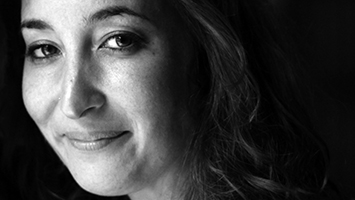
What kinds of worlds do not yet fully exist for these people that they would like to see enacted? And they just sort of come together and they know. World-making is the willful and relentless enactment of the self that creates a world in which they are possible. There are trans artists and people who are gender nonconforming or people who don’t quite fit categories in which they are comfortable. It is the mere act of creating the worlds in which they exist and reaffirmed, not only for themselves but for their audience. When you ask: “Does it actually work?” I would ask, “For whom?”
Marlène Ramírez-Cancio is an interdisciplinary artist from Puerto Rico who co-founded and co-directs Fulana, a Latina video collective based in New York City. Using parody and satire as a critical tool, Fulana’s faux television commercials, music videos, and print pieces respond to the ways ideologies and identities are marketed through the mass media. She is currently Associate Director of Arts & Media at the Hemispheric Institute of Performance and Politics. There, she facilitates EMERGENYC, a program that fosters the growth and development of emerging artistic activists.
Steve Duncombe: Marlene, could you explain just in a couple of sentences what your practice as an artist is?
Marlène Ramírez-Cancio: Okay. What I have done since the ’90s to now has mostly had to do with satire and parody. Initially, with theater and women’s groups where we would write and direct and perform in our own pieces. Then, later, more on videos, even though it still had some stage elements in it like video parodies, etc. has morphed within that role to pedagogy and teaching — satire as a teaching tool, teaching it for different college-age and above audiences.
As an opener of spaces for artists, and especially emerging artists, you have to think about: What’s the point? Why am I bothering to have these programs that are hard to pull off, that have no funding, that get people together?
SD: What would an example of one of these programs be?
MRC: One of them would be EMERGENYC, which is a program with the Hemispheric Institute where I’m Associate Director, that has been going on for the past 10 years. We get together a group of about 18 emerging artists who want to explore whatever performance politics means for them. It’s not like a conservatory where they hone their craft in a traditional way, but a place where they can delve into what’s pissing them off in the world, and what’s their stake. And, importantly, its a way to create a community of artists around them that they’re not perhaps finding in other circles. It’s for artists who are trying to engage in what José Esteban Muñoz would always call “world-making,” yeah?
SD: Right.
MRC: It’s like, what kinds of worlds do not yet fully exist for these people that they would like to see enacted? And they just sort of come together and they know. World-making is the willful and relentless enactment of the self that creates a world in which they are possible. There are trans artists and people who are gender nonconforming or people who don’t quite fit categories in which they are comfortable. It is the mere act of creating the worlds in which they exist and reaffirmed, not only for themselves but for their audience. When you ask: “Does it actually work?” I would ask, “For whom?”
In that sense, I remember one time Holly Hughes was talking about WOW Café in the ’80s, and she talked about going to that tiny, tiny space for women and for queers as almost like going to church, because it was a place where they felt they were creating the possibility for their very existence in a world that wasn’t really there for them. When I’ve talked to folks that talk about the black church, for example, whole trajectory of worlds in which they were under Jim Crow, or worse. But within the structures of the church, they had power. There was an actual structure, structures of respect and of something that did not exist out there in the world where they were still being called “boy.” So, I understood when she said it was like going to church, it’s like: Yes. In here, we are creating this world for ourselves first, and that matters. Because without that, how do you then go out there?
an EMERGENYC alumni who works with folks with kids in homeless shelters. She was saying that we want people to vote, we want people to go out there and demand, but if you don’t even know that you exist, how do you even go out there and demand? She said: “I exist, therefore, I demand,” and you have to get them to feel like, “I exist and I have opinions.” It’s like basic, basic, basic. Without that, you don’t get anything else.
is for folks who don’t already have that in the world; that don’t expect to be listened to and don’t see those universes — even small, like an audience of three — doing work that works. A lot of that work has to do with feeling, so they make people feel something first and then they get to think about it.
SD: Why is the feeling important?
MRC: Because it’s how the work first impacts you. It makes you feel something. I think in my experience, and I think in general people might agree, a lot of art is not necessarily thinking first. You might think about it later, but it impacts you somehow, whether it makes you laugh or whether it’s something that makes you sad. You have empathy, those are all feelings. And then you might reflect and think about the issue, but it’s not like reading an essay. It’s a different form of expression. You could go out and write an essay. You could go write an op-ed. You could write a book. You could do a performance. You could do a satire. There’s all different ways, so for me-
SD: You say that in generosity.
MRC: I think we need it all. It’s like when I hear people starting to get into their camps as if the one thing they do is the one right thing or the best way, it’s like no, no. That’s the way you are choosing to do it that’s just one way. We need all of it. For the worlds we open up, there’s ways in which other things happen, too, in terms of feelings.

From “Tea Harmony: Fall in Love for all the Far Right Reasons” by Fulana, Ramirez-Cancio’s satire collective.
SD: Let’s go back to this idea of what precedes voting, the demand to vote. If you said, “Look, the call is really to make art to make people vote,” then it’s pretty easy to assess the success of that, right?
MRC: Right.
SD: Then people go and vote. It’s easy, right? But how do we know when we’ve been successful in world-making?
MRC: Right, that’s the hard thing. I hate when it’s like: “I’m going to do this performance and you’re going to think this and I’m going to pass this information to you.” Really it’s like: you might think that you’re doing one thing and it might be received in a completely different way because that person heard something else before that sounded sort of like what you just said and they completely took it in another direction. You have no freaking idea.
So, it doesn’t bother me, I guess, to not know. Because at base level, the people involved in whatever we’re doing — whether it’s a collective thing, if you’re doing an action, or a performance — there’s already probably some “work” being done, some transformational things happening.
I wish I could quote her perfectly, but I saw an interview with Emma Gonzalez, who was one of the survivors of the Parkland shooting, who said explicitly that if it hadn’t been for her ninth grade creative writing class, in which she got to understand that she was queer, she would have never gotten involved with queer activism at her school. If she hadn’t been involved with queer activism at her school, she would have never been ready to take nationwide and been able to stand in front of everybody and be like, “We just got shot at and people died, and this is why this is so messed up.” She, herself, made the connection to her 14-year-old . That teacher had no idea.
I guess I’m an optimist. It’s different paths. I would never say: “This is the most important” or “This is the one correct way.” One thing that I don’t like is when folks dismiss the as something that “is just making you feel good about yourself,” and that’s it. It’s dismissed as if you’re not really doing anything, like that has no impact in the world. Instead, it’s: “Let’s talk real political work.” That, I have little patience for. It’s like, really? I invite you. Come over here, just sit, papi. Tell those people to their face that this is making no difference to anybody. Not true!
SD: Let’s go back to this notion of world-making and the idea that it’s really important to create a world in which you see yourself and others see you as belonging in it, empowered, and so on and so forth.
You’re someone who develops programs to help artists do this sort of work. So, you must think sometimes: How can I help this person best actualize that? Which seems to me that you’re also thinking at some level: “Is this person actualizing this for themselves or are they lost? Are they getting sucked back into art school patterns or other sort of bullshit that allows them to do what they intend to do?” Which means at some level, you are thinking about “is this working or not working,” right?
MRC: Yeah. It’s funny. I just had an experience at OSF hearing Nana speak about her project. She’s Ghanaian and she wants to do a pan-African encyclopedia, like a virtual thing. Her posture, the way she was sitting, the way she was talking, she was lit up. I mean, this person was aligned. You could see. I loved how her philosophy of how she was doing her work research was very intuitive. I loved watching somebody be so connected to the work they are doing. It has to do with everything: arts, culture, politics, spirituality. It’s all connected.
I just saw a very aligned person, which was beautiful. I don’t know what to tell you in terms of “how do I know?” . I also don’t have the funding to follow up systematically with everyone. But I can see generosity is something I’ve identified over the years in people that continue to open up spaces for other people. I can observe who is thinking: “How can I help this person? How do we connect with each other?” We’re going to live and then we’re going to die, so might as well just live as connectedly as possible.

Image from Tercer Impacto, Fulana’s satirical news program
SD: I love this idea of the success in this case being someone who– I don’t know if she would describe it this way — knows who she is, knows what her practice is, knows her place in her practice.
Without naming any names or even giving any descriptions, have you ever come across someone who’s just not finding or creating that world for themselves?
MRC: Most people I see continue to show up and they continue to do the work. Even when I’ve seen they’re in a moment of things not working, when they get disconnected and there’s a lot of self-doubt and isolation, predictably. But I haven’t yet had the experience, unless I’m totally blanking out, and I might well be, where somebody just went in a completely different direction. Even if they went into non-artistic things, I still see the effects.
SD: I think you are too nice Marlene. You seem to will-away indicators of when it isn’t working for them. Why do you think that you’re always looking for success?
MRC: I just don’t know that . I know what you’re asking: Is the thing that they’re trying to do working or not working? I guess they don’t talk about it in those terms.
It’s like, did some kid have this transformational experience from the program that they were in and then they were able to blah, blah, blah? I hear anecdotes, but I don’t get a lot of numbers, that kind of stuff. Even with folks that are in the life and are continuing to do it, I don’t get a lot of evidence that would be measurable in other ways.
I’m trying. I’m trying.
SD: I think we are always trying because we don’t really have a vocabulary to talk about how socially engaged art works. We have the vocabulary to talk about material success, but we don’t have a vocabulary to talk about what you’re talking about. And so evaluation and assessment and metrics just becomes about banal forms of measurement.
MRC: Right. One of the people that’s in Nana’s videos was a young Ghanaian artist. He was wearing a shirt that said, “Kiss my black arts,” which I loved. People are living in their universes of creativity and they are waking up in the morning and are all about it, and their kids are growing up in it, and it’s like a whole integrated thing.
I don’t know how to name that. How do you quantify that? I don’t . You are happy. Your life is worth living, because you wake up in the morning and you feel motivated. Are funders really that dense that they don’t have a heart themselves? They can’t meet with the artist and be like, “That’s working. I’m looking at it that works.” I guess that’s the thing that I would question: Are funders not people? What is it about these metrics that they need an excess of that they can’t see with their own eyes and they can’t feel when they talk to their grantees? I don’t understand.
If you’re talking about delivering 50,000 gallons of milk to the community, that’s a different goal. But when you’re talking about the arts, I don’t know why you have any business being an arts funder if you don’t understand wellbeing as a holistic thing that to do with how you feel when you wake up in the morning and how you’re making people around you feel and how you’re making a community feel. I guess I would have to wonder: What do they need?




You must be logged in to post a comment.